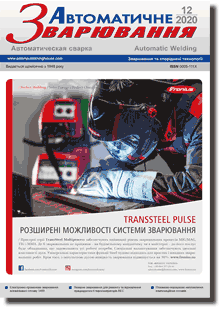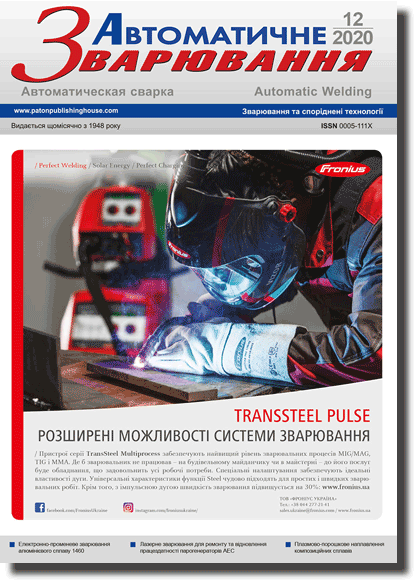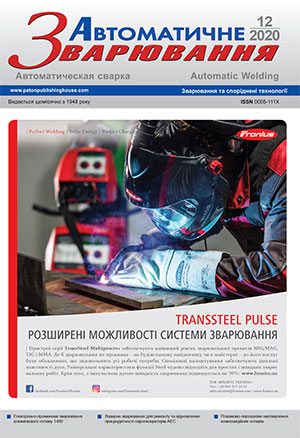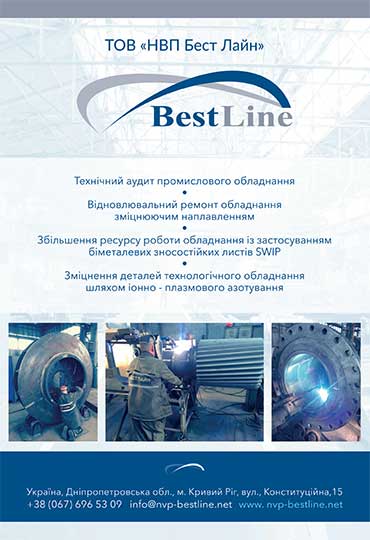| 2020 №12 (02) |
DOI of Article 10.37434/as2020.12.03 |
2020 №12 (04) |

"Avtomatychne Zvaryuvannya" (Automatic Welding), #12, 2020, pp. 23-29
Influence of pulsed-arc welding conditions on change of parameters of weld and haz of welded joints and mechanical properties of lowalloy steels
A.V. Zavdoveev1, V.D. Poznyakov1, S.L. Zhdanov1, M. Rogante2, T. Baudin3
1E.O. Paton Electric Welding Institute of the NAS of Ukraine. 11 Kazymyr Malevych Str., 03150, Kyiv, Ukraine. E-mail: office@paton.kiev.ua
2Rogante Engineering Office, 62012 Civitanova Marche, Italy. E-mail: main@roganteengineering.it
3Université Paris-Saclay, CNRS, Institut de chimie moléculaire et des matériaux d’Orsay, 91405 Orsay, France. E-mail: thierry.baudin@u-psud.fr
Pulsed-arc welding is characterized by a periodical changing in arc power and, due to its features, allows solving complex technological problems while creating unique structures, increasing efficiency of welding processes while maintaining a high level of physical and mechanical properties of welded joints. There are many manufacturers of welding equipment, that introduced the idea of using pulsed welding in their production, but data on the impact of pulsed-arc welding on the parameters of the welds differ. For the successful application of pulsed-arc welding in modern production, it became necessary to study the influence of pulsed-arc welding conditions on the parameters of welds and HAZ as compared to stationary welding using burning arc, made of low-alloy welding materials. 20 Ref., 7 Fig.
Keywords: pulsed-arc welding, pulsating arc welding, heat-affected-zone, low-alloy welding materials
Received: 29.10.2020
References
1. Poznyakov, A.A., Zavdoveev, A.V., Gajvoronsky, A.A., Denisenko A.M. (2018) Effect of pulsed-arc welding modes on the change of weld metal and haz parameters of welded joints produced with Sv-08kh20N9G7T wire. The Paton Welding J., 9, 7-12. https://doi.org/10.15407/tpwj2018.09.022. Palani, P.K., Murugan, N. (2006) Selection of parameters of pulsed current gas metal arc welding. J. of Materials Processing Technology, 172, 1-10. https://doi.org/10.1016/j.jmatprotec.2005.07.013
3. Tong, H., Ueyama, T. et al. (2001) Quality and productivity improvement in aluminium alloy thin sheet welding using alternating current pulsed metal inert gas welding system. Sci. Technol. Weld. Join., 6, 4, 203-208. https://doi.org/10.1179/136217101101538776
4. Needham, J.C., Carter, A.W. (1965) Material transfer characteristics with pulsed current. Brit. Welding. J., 5, 229-241.
5. Rajasekaran, S. (1999) Weld bead characteristics in pulsed GMA welding of Al-Mg alloys. Welding. J., 78, 12, 397-407.
6. Zavdoveev, A., Rogante, M., Poznyakov, V. et al. (2020) Development of the PC-GMAW welding technology for TMCP steel in accordance with welding thermal cycle, welding technique, structure and properties of welded joints. Reports in Mechanical Engineering, 1, 1, 26-33. https://doi.org/10.31181/rme200101026z
7. Zavdoveev, A., Poznyakov, V., Kim, H.S. et al. (2020) PCGMAW effect on the welding thermal cycle and weld metal geometry for high strength steels. International J. of Engineering and Safety Sciences, 1, 5-16.
8. Murray, P.E. (2002) Selecting parameters for GMAW using dimensional analysis. Welding J., 81, 7, 125-131.
9. Amin, M., Ahmed N. (1987) Synergic control in MIG welding 2-power current controllers for steady dc open arc operation. Metal Construction, June, 331-340.
10. Amin, M. (1983) Pulse current parameters for arc stability and controlled metal transfer in arc welding. Ibid, May, 272-377.
11. Lambert, J.A. (1989) Assessment of the pulsed GMA technique for tube attachment welding. Welding J., 68, 2, 35-43.
12. Essers, W.G. Van Gompal (1984) Arc control with pulsed GMA welding. Ibid, 64, 6, 26-32.
13. Amin, M. (1981) Synergetic pulse MIG welding. Metal Construction, 6, 349-353.
14. Dorn, L., Devakumaran, K., Hofmann, F. (2009) Pulsed current gas metal arc welding under different shielding and pulse parameters. Part 2. Behaviour of metal transfer. ISIJ international, 49. 2, 261-269. https://doi.org/10.2355/isijinternational.49.261
15. Paton, B.E., Potapievsky, A.G, Podola, N.V. (1964) Consumable electrode pulsed-arc welding with programmed adjustment of process. Avtomatich. Svarka, 1, 2-6 [in Russian].
16. Tomoyuki Ueyama (2013) Trends in developments in gas shielded-arc welding equipment in Japan. Ibid., 10, 51-58.
17. Lashchenko, G.I. (2006) Methods of consumable electrode arc welding of steel. Kiev, Ekotekhnologiya [in Russian].
18. Zhuo, Y., Yang, C., Fan, C. et al. (2020) Grain refinement of wire arc additive manufactured titanium alloy by the combined method of boron addition and low frequency pulse arc. Materials Sci. and Eng: A, 14055 https://doi.org/10.1016/j.msea.2020.140557
19. Saraev, Y.N., Solodskiy, S.A., Ulyanova, O.V. (2016) Improving Processes of Mechanized Pulsed Arc Welding of Low-Frequency Range Variation of Mode Parameters, IOP Conf. Ser. Mater. Sci. Eng. 127, 12019. https://doi.org/10.1088/1757-899X/127/1/012019
20. Chen, C., Fan, C., Cai, X. et al. (2019) Arc characteristics and weld appearance in pulsed ultrasonic assisted GTAW process. Results Phys., 15. 102692. https://doi.org/10.1016/j.rinp.2019.102692
Advertising in this issue:
The cost of subscription/purchase order journals or individual articles
| Journal/Currency | Annual Set | 1 issue printed |
1 issue |
one article |
| TPWJ/USD | 384 $ | 32 $ | 26 $ | 13 $ |
| TPWJ/EUR | 348 € | 29 € | 24 € | 12 € |
| TPWJ/UAH | 7200 UAH | 600 UAH | 600 UAH | 280 UAH |
| AS/UAH | 1800 UAH | 300 UAH | 300 UAH | 150 UAH |
| AS/USD | 192 $ | 32 $ | 26 $ | 13 $ |
| AS/EUR | 180 € | 30 € | 25 € | 12 € |
| SEM/UAH | 1200 UAH | 300 UAH | 300 UAH | 150 UAH |
| SEM/USD | 128 $ | 32 $ | 26 $ | 13 $ |
| SEM/EUR | 120 € | 30 € | 25 € | 12 € |
| TDNK/UAH | 1200 UAH | 300 UAH | 300 UAH | 150 UAH |
| TDNK/USD | 128 $ | 32 $ | 26 $ | 13 $ |
| TDNK/EUR | 120 € | 30 € | 25 € | 15 € |
AS = «Automatic Welding» - 6 issues per year;
TPWJ = «PATON WELDING JOURNAL» - 12 issues per year;
SEM = «Electrometallurgy Today» - 4 issues per year;
TDNK = «Technical Diagnostics and Non-Destructive Testing» - 4 issues per year.









